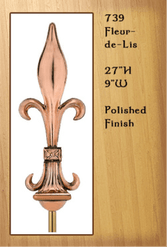What are Finials?

While Greeks and Romans occasionally adorned their buildings with finials, they did not become a prominent architectural design element until around 711 A.D. The trend gained popularity in Asia, where finials were used to ornament the tops of pagodas. Pagodas are temples or other sacred buildings with a pyramid-like tower and upward-curving roofs. A central finial would be placed on the very top of the highest roof, with smaller finials gracing the upturned corners of each eave.
Many of these initial finials were made out of stone, and their designs were heavily influenced by Buddhism. The most common design was that of a lotus bud: a closed bud represented the potential for enlightenment, while an open bud represented rebirth. The Japanese began making finials out of metals, such as iron and copper, but they kept Buddhist symbolism in their designs. (These included the sacred wheel, the water flame, and nine rings stacked vertically to represent the Buddhist deities.)
Finials saw a resurgence in use during the Victorian and Gothic eras. Designs based on Arthurian legends became popular, such as the Gawain, Merlin, and Lancelot finials. Gothic finials also typically included ornamental figures such as gargoyles, dragons, and other mythical creatures. Victorian finials tended more toward regal designs, such as the fleur de lis.
Find the Perfect Finial at Valley Forge Cupolas and Weathervanes
- Verdigris
- Black matte
- Black gloss
- White antique
- White gloss
- Nickel brushed
- Nickel polished


 RSS Feed
RSS Feed